| |
| 1989 |
|
Potential
Source 1
The first
decoloration
installation.
Decoloration:
10m x 10m x 4m(h)
5
concrete basins, red cloth, bleaching water
Coloration:
10m long white cloth, blue paint
(Rochefort-sur-Mer, France)
|
|
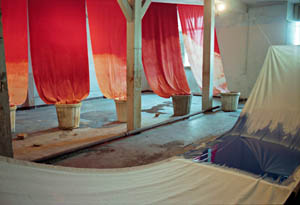 |
| |
| 1990 |
 |
Potential
Source 2
Decoloration
installation:
8m x 6m x 3,2m(h)
Wall sculptures: 4,5m x 1,5m - red cloth, 5 drum cans, water
(Three artists' show
Nuremberg, Germany) |
|
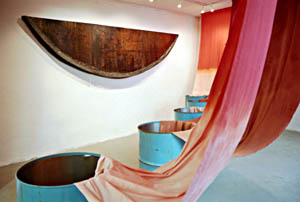 |
| |
The decolorization
installations
are made of bleaching water in which are soaked red cloths... The
artist plays with the opposite effect, with the negative action. Oil
painting coats white cloth, bleaching water erodes colors, strips it
from the cloth, and lets appear hidden colors. Decolorization is only
partial, it offers a subtle gradation of colors, without contrast. The
color of red cloth is the most explicit because it reveals a yellow
color contained in it: decolorizing means "uncovering the colors that
are hidden under the visible color". Finally, the aggressivness of the
bleaching water produces aureoles that integrate well in the gradation
of colors.
|
| |
| 1991 |
 |
Untitled
2,5m x 2,7m(h)
Decolored black cloth,
hoses
(Solo Show,
Gallery Jacques Losserand, Annecy, Fr.)
|
|
|
|
| |
| 1992 |
 |
Decolored
cloth installation
4,5m x 3,7m(h)
(Views of Solo Show,
Gallery Pascal Polar, Brussels, Belgium)
|
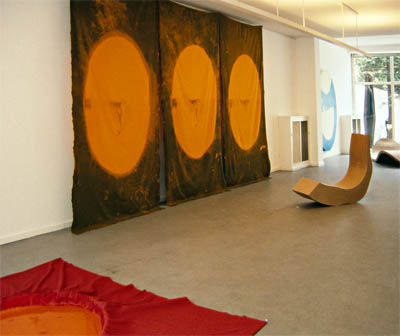 |
| |
| 1992 |
outdoor
decoloration
in progress
|
The first
outdoor decoloration
Element: 3m x 2,6m
red cloth, elliptical basins, water, bleaching water
In the garden of the Gallery Pascal Polar, Brussels, Belgium
|
|
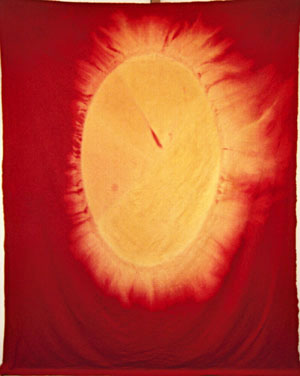
Result of the
outdoor decoloration
350cm x 260cm
|
|
This
first decoloration to sunlight exposure shows a new shape appearing on
the cloth, as if the sun had drawn its flames on it. Since then, the
sun became the principal element of the decoloration work.
Why elliptic? ... text of Shigeko Hirakawa "Ellipse" |
|
| 1993 |
|
Decoloration
Factory
10m x 7m x 3,7m(h)
3 coths decolored in Brussels,
wood structure, violet cloth, bleaching water
(Gallery Espace Archidé, Paris)
|
|
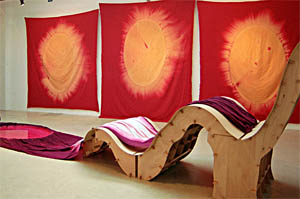 |
| |
| |
Blue Ellipse 1992
230 x 165 cm
(private collection)
|

Red Ellipse
1993
230x165cm
(private collection)
|
|
|
|
|
|
|
230cm x 165cm
Sunlight Decoloration on baord
|
| |
| 1993 |
 |
 |
Decoloration
&
Destruction
11m x
3,8m(h)
(Solo Show,
Gallery Imperts,
Wroclaw, Pologne) |
|
|
| |
| 1994 |
 |
 |
Summer
Decoloration (left)
Winter Decoloration (right)
each element :
260cm x 300cm(h)
(Solo Show, Gallery Lunami, Tokyo) |
|
|
| |
| |
 |
At the
beginning of Toric
Decoloration Torus |
|
|
|
| |
Bleaching water is a chemical that acts autonomously : "it prevents me
from intervening" says Hirakawa who attends the process, letting the
chemical act and the cloth react. For every decolorization it is
necessary to proceed in a different way, because the reaction is always
different : the cloth may be eroded or the decolorization may be
insufficient. The cloths soaked in bleaching water are contained within
basins which shapes evoke an ellipse or a torus, and this explains the
results of these productions.
|
| |
1995
|

|
Toric
Decoloration
1995
14 decolored red cloth
elements, each
element : 260cm x 300cm
|
(Solo Show,
Freiburg City Gallery,
Germany)
|
|
|
1995-
1996 |
Cosmogony
1995
installation :
3m x 7m
(Solo Show,
Gallery Tom, Tokyo) |

private
collection |
|
|
|
| |
| |
|
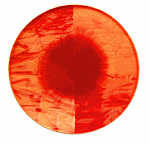 |
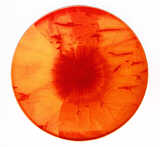 |
Series: Dé-peindre
1996
154cm in
diameter
decolored cloth on wood
|
|
| |
| 1998 |
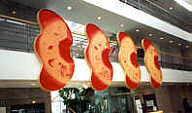 |
Dé-peindre
1997
Installation:
7,5m x 2,75m(h)
4 elements of 275cm x 150cm, decolored cloth on wood
(Views:
Solo Show
"Peintures, Sculptures"
Choisy-le-Roi City Hall, France) |
studio |
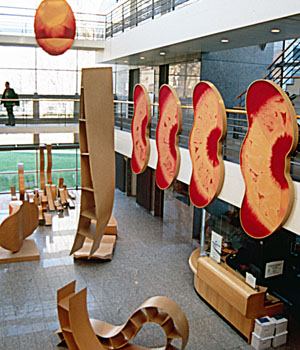 |
| |
| |
|
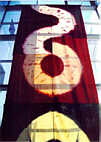
|
Dé-peindre
/ Tore & Torus 1995-97
3m x 8m(h)
decolored cloth
(SoloShow, Choisy-le-Roi City Hall, Fr.) |
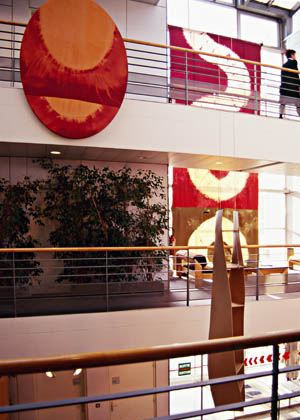 |
| |
| 1999 |
Collection of Graduate
School
of
Mathematical Sciences,
University of Tokyo
(Tokyo, Komaba) |
Five Red
Spheres 1999
Element:
154cm in diameter,
Installation: 15m long
decolored red cloth on wood, vernish
|
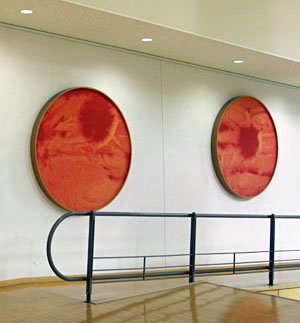 |
|
|
Installation "Five Red Spheres" on the 15m-long
wall
(Photography in 2009, S.H.) |
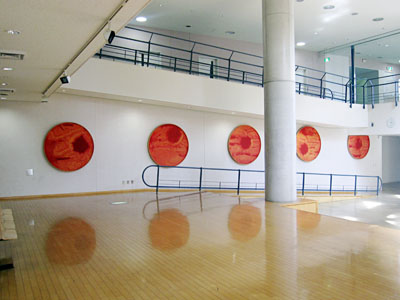
|
| |